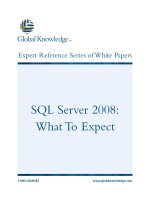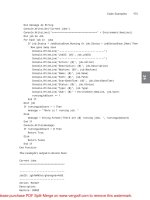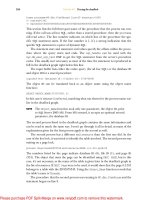Tài liệu SQL Clearly Explained- P10 doc
Bạn đang xem bản rút gọn của tài liệu. Xem và tải ngay bản đầy đủ của tài liệu tại đây (293.84 KB, 46 trang )
414 Chapter 19: Object-Relational Support
retrieve just the value of a single column, we use “dot” nota-
tion. e rst portion—
DEREF(related_ingredient)
—actually performs the dereference. e portion to the right
of the dot species the column in the referenced row.
Some DBMSs provide a dereference operator (->) that can be
used in place of the DEREF function. e preceding query
might be written:
SELECT
related_ingredient->ingredient_name, amount
FROM ingredient_amount;
e UDTs that we have seen to this point have attributes, but
not methods. It is certainly possible, however, to declare meth-
ods as part of a UDT and then to use SQL programming to
dene the body of the methods. Like classes used by OO pro-
gramming languages such C++, SQL the body a method is
dened separately from the declaration of the UDT.
You declare a method after declaring the structure of a UDT.
For example, we could add a method to display the instruc-
tions of a recipe with
CREATE TYPE recipe_type AS OBJECT
(recipe_name CHAR (256),
instruction_list instruction ARRAY[20],
numb_servings INT)
NOT INSTANTIABLE,
NOT FINAL
METHOD show_instructions ();
is particular method does not return a value and the dec-
laration therefore does not include the optional RETURNS
clause. However, a method to compute the cost of a recipe (if
we were to include ingredient costs in the database) could be
declared as
Methods
Methods 415
Dening Methods
Executing Methods
CREATE TYPE recipe_type AS OBJECT
(recipe_name CHAR (256),
instruction_list instruction ARRAY[20],
numb_servings INT)
NOT INSTANTIABLE,
NOT FINAL
METHOD show_instructions ()
METHOD compute_cost ()
RETURNS DECIMAL (5,2));
Methods can accept input parameters within the parentheses
following the method name. A method declared as
METHOD scale_recipe (IN numb_servings INT):
accepts an integer value as an input value. e parameter list
can also contain output parameters (OUT) and parameters
used for both input and output (INOUT).
As mentioned earlier, although methods are declared when
UDTs tables are declared, the bodies of methods are written
separately. To dene a method, use the CREATE METHOD
statement:
CREATE METHOD method_name FOR UDT_name
BEGIN
// body of method
END
A SQL-only method is written using the language constructs
discussed in Chapter 14.
Random programming note: Like the C++ and Java “this,” SQL
methods use SELF to refer to the object to which the method
belongs.
Executing a method uses the “dot” notation used in C++:
typed_table_name.method_name (parameter_list);
416 Chapter 19: Object-Relational Support
Such an expression can be, for example, included in an IN-
SERT statement to insert the method’s return value into a
column. It can also be included in another SQL method, trig-
ger, or stored procedure. Its return value can then be captured
across an assignment operator. Output parameters return their
values to the calling routine, where they can be used as needed.
Appendix
A
419
Abbreviation/
Acronym
Denition
1:1 One-to-one
1:M One-to-many
ANSI American National Standards Institute
API Application Program (or Programmer) Interface
ASCII American Standard Code for Information Interchange
CHAR Character
CLI Command-line interface
CTE Common table expression
DBA Database administrator or Database administration
DBMS Database management system
DTD Document type denition
ER Entity relationship
ERD Entity relationship diagram
FK or fk Foreign key
GUI Graphic user interface
HTML Hypertext markup language
IE Information Engineering
INT Integer
Common Acronyms
and Abbreviations
420 Appendix A: Common Acronyms and Abbreviations
ISO International Standards Organization
JDBC Java Database Connectivity
M:M Many-to-many
M:N Many-to-many
NIST National Institute for Standards and Technology
OO Object-oriented
OODBMS Object-oriented database management system
OOP Object-oriented programming
OR Object-relational
PK or pk Primary key
PSM Persistent stored modules
RDMBS Relational database management system
SQL Structured query language
UDF User-dened function
UDT User-dened type; user-dened data type
URI Uniform resource identier
URL Uniform resource locator
UML Unied modeling language
VARCHAR Character varying
XML Extended (Extensible) Markup Language
Appendix
B
421
SQLSTATE Return
Codes
is appendix contains a numeric listing of the SQLSTATE re-
turn codes specied in the SQL standard (Table B-1). SQLSTATE
is a ve-character string. e leftmost two characters represent the
error class; the rightmost three characters represent the subclass.
Because SQLSTATE is a string, an embedded SQL program will
need to use a substring function if it needs to separate the two
parts of the code.
422 Appendix B: SQLSTATE Return Codes
Table B-1: SQLSTATE return codes
Class Class denition Subclass Subclass denition
00 Successful completion 000 None
01 Warning 000 None
001 Cursor operation conict
002 Disconnect error
003 Null value eliminated in set function
004 String data, right truncation
005 Insucient item descriptor area
006 Privilege not revoked
007 Privilege not granted
008 Implicit zero-bit padding
009 Search expression too long for information
schema
00A Query expression too long for information
schema
00B Default value too long for information
schema
00C Result sets returned
00D Additional result sets returned
00E Attempt to return too many result sets
00F Statement too long for information schema
010 Column cannot be mapped (XML)
011 SQL-Java path too long for information
schema
02F Array data, right truncation
02 No data 000 None
001 No additional result sets returned
07 Dynamic SQL error 000 None
001 Using clause does not match dynamic
parameter
002 Using clause does not match target
specications
423
003 Cursor specication cannot be executed
004 Using clause required for dynamic
parameters
005 Prepared statement not a cursor
specication
006 Restricted data type attribute violation
007 Using clause required for result elds
008 Invalid descriptor count
009 Invalid descriptor index
00B Data type transform function violation
00C Undened DATA value
00D Invalid DATA target
00E invalid LEVEL value
00F Invalid
DATETIME_INVERTVAL_CODE
08 Connection exception 000 None
001 SQL client unable to establish SQL
connection
002 Connection name in use
003 Connection does not exist
004 SQL server rejected establishment of SQL
connection
006 Connection failure
007 Transaction resolution unknown
09 Triggered action exception 000 None
0A Feature not supported 000 None
001 Multiple server transactions
0D Invalid target type specication 000 None
0E Invalid schema name list specication 000 None
0F Locator exception 000 None
001 Invalid specication
0K Resignal when handler not active 000 None
0L Invalid grantor 000 None
424 Appendix B: SQLSTATE Return Codes
0M Invalid SQL-invoked procedure
reference
000 None
0N SQL/XML mapping error 000 None
001 Unmappable XML name
002 Invalid XML character
0P Invalid role specication 000 None
0S Invalid transform group name
specication
000 None
0T Target table disagrees with cursor
specication
000 None
0U Attempt to assign to non-updatable
column
000 None
0V Attempt to assign to ordering column 000 None
0W Prohibited statement encountered
during trigger execution
000 None
0X Invalid foreign server specication 000 None
0Y Pass-through specic condition 000 None
001 Invalid cursor option
002 Invalid cursor allocation
0Z Diagnostics exception 001 Maximum number of stacked diagnostics
area exceeded
002 Stacked diagnostics accessed without active
hander
10 XQuery error 000 None
20 Case not found for CASE statement 000 None
21 Cardinality violation 000 None
22 Data exception 000 None
001 String data, right truncation
002 Null value, no indicator
003 Numeric value out of range
004 Null value not allowed
005 Error in assignment
006 Invalid interval fomat
007 Invalid datetime format
425
008 Datetime eld overow
009 Invalid time zone displacement value
00B Escape character conict
00C Invalid use of escape character
00D Invalid escape octet
00E Null value in array target
00F Zero-length character string
00G Most specic type mismatch
00H Sequence generator limit exceeded
00J Nonidentical notations with the same name
(XML)
00K Nonidentical unparsed entities with the
same name (XML)
00L Not an XML document
00M Invalid XML document
00N Invalid XML content
00P Interval value out of range
00Q Multiset value overow
00R XML value overow
00S Invalid XML comment
00T Invalid XML processing instruction
00U Not an XQuery document node
00V Invalid XQuery context item
00W XQuery serialization error
010 Invalid indicator parameter value
011 Substring error
012 Division by zero
015 Interval eld overow
017 Invalid data specied for datalink
018 Invalid character value for cast
019 Invalid escape character
426 Appendix B: SQLSTATE Return Codes
01A Null argument passed to datalink
constructor
01B Invalid regular expression
01C Null row not permitted in table
01D Datalink value exceeds maximum length
01E Invalid argument for natural logarithm
01F Invalid argument for power function
01G Invalid argument for width bucket function
01J XQuery sequence cannot be validated
01K XQuery document node cannot be
validated
01L No XML schema found
01M Element namespace not declared
01N Global element not declared
01P No XML element with the specied
QName
01Q No XML element with the specied
namespace
01R Validation failure
01S invalid XQuery regular expression
01T Invalid XQuery option ag
01U Attempt to replace a zero-length string
01V Invalid XQuery replacement string
021 Character not in repertoire
022 Indicator overow
023 Invalid parameter value
024 Unterminated C string
025 Invalid escape sequence
026 String data, length mismatch
027 Trim error
029 Noncharacter in UCS string
02A Null value in eld reference
427
02D Null value substituted for mutator subject
parameter
02E Array element error
02F Array data, right truncation
02H Invalid sample size
23 Integrity constraints violation 000 None
001 Restrict violation
24 Invalid cursor state 000 None
25 Invalid transaction state 000 None
001 Active SQL transaction
002 Branch transaction already active
003 Inappropriate access mode for branch
transaction
004 Inappropriate isolation level for branch
transaction
005 No active SQL transaction for branch
transaction
006 Read-only SQL transaction
007 Schema and data statement mixing not
supported
008 Held cursor requires same isolation level
26 Invalid SQL statement name 000 None
27 Triggered data change violation 000 None
28 Invalid authorization specication 000 None
2A Syntax error or access rule violation in
direct SQL statement
000 None
2B Dependent privilege descriptors still
exist
000 None
2C Invalid character set name 000 None
2D Invalid transaction termination 000 None
2E Invalid connection name 000 None
2F SQL routine exception 000 None
002 Modifying SQL data not permitted
003 Prohibited SQL statement attempted
428 Appendix B: SQLSTATE Return Codes
004 Reading SQL data not permitted
005 Function executed but no return statement
2H Invalid collation name 000 None
30 Invalid SQL statement identier 000 None
33 Invalid SQL descriptor name 000 None
34 Invalid cursor name 000 None
35 Invalid condition number 000 None
36 Cursor sensitivity exception 000 None
001 Request rejected
002 Request failed
37 Syntax error or access rule violation in
dynamic SQL statement
000 None
38 External routine exception 000 None
001 Containing SQL not permitted
002 Modifying SQL not permitted
003 Prohibited SQL statement attempted
004 Reading SQL data not permitted
39 External routine invocationexception 000 None
004 Null value not allowed
3B Savepoint exception 000 None
001 Invalid specication
002 Too many
3C Ambiguous cursor name 000 None
3D Invalid catalog name 000 None
3F Invalid schema name 000 None
40 Transaction rollback 000 None
001 Serialization failure
002 Integrity constraint violation
003 Statement completion unknown
42 Syntax error or access rule violation 000 None
44 With check option violation 000 None
45 Unhandled user dened exception 000 None
46 Java DDL 000 None
429
001 Invalid URL
002 Invalid JAR name
003 Invalid class deletion
005 Invalid replacement
00A Attempt to replace uninstalled JAR
00B Attempt to remove uninstalled JAR
00C Invalid JAR removal
00D Invalid path
00E Self-referencing path
46 Java execution 000 None
102 Invalid JAR name in path
103 Unresolved class name
110 Unsupported feature
120 Invalid class declaration
121 Invalid column name
122 Invalid number of columns
130 Invalid prole state
HV FDW-specic condition 000 None
001 Memory allocation error
002 Dynamic parameter value needed
004 Invalid data type
005 Column name not found
006 Invalid data type descriptors
007 Invalid column name
008 Invalid column number
009 Invalid use of null pointer
00A Invalid string format
00B Invalid handle
00C Invalid option index
00D Invalid option name
00J Option name not found
430 Appendix B: SQLSTATE Return Codes
00K Reply handle
00L Unable to create execution
00M Unable to create reply
00N Unable to establish connection
00P No schemas
00Q Schema not found
00R Table not found
010 Function sequence error
014 Limit on number of handles exceeded
021 Inconsistent descriptor information
024 Invalid attribute value
090 Invalid string length or buer length
091 Invalid descriptor eld identier
HW Datalink exception 000 None
001 External le not linked
002 External le already linked
003 Referenced le does not exist
004 Invalid write token
005 Invalid datalink construction
006 Invalid write permission for update
007 Referenced le not valid
HY CLI-specic condition 000 None
001 Memory allocation error
003 Invalid data type in application descriptor
004 Invalid data type
007 Associated statement is not prepared.
008 Operation canceled
009 Invalid use of null pointer
010 Function sequence error
011 Attribute cannot be set now
431
012 Invalid transaction operation code
013 Memory management error
014 Limit on number of handles exceeded
017 Invalid use of automatically-allocated
descriptor handle
018 Server declined the cancelation request
019 Non-string data cannot be sent in pieces
020 Attempt to concatenate a null value
021 Inconsistent descriptor information
024 Invalid attribute value
055 Non-string data cannot be used with string
routine
090 Invalid string length or buer length
091 Invalid descriptor eld identier
092 Invalid attribute identier
093 Invalid datalink value
095 Invalid FunctionID specied
096 Invalid information type
097 Column type out of range
098 Scope out of range
099 Nullable type out of rage
103 Invalid retrieval code
104 Invalid LengthPrecision value
105 Invalid parameter mode
106 Invalid fetch orientation
107 Row value of range
109 Invalid cursor position
C00 Optional feature not implemented
Appendix
C
433
is appendix contains a summary of SQL syntax used
throughout this book. e rst table (Table C.1) describes
SQL statements, arranged alphabetically command. e no-
tation is as follows:
◊ Keywords that must be typed exactly as they appear are
in uppercase characters, such as REFERENCES.
◊ Parts of commands that are determined by the user ap-
pear in italics and name the item that must be supplied,
such as table_name.
◊ Optional portions of a command are surrounded by
brackets ([ and ]).
◊ Portions of commands that form a single clause are
grouped within braces ({ and }).
◊ Sets of options from which you choose one or more are
separated by vertical lines (|).
◊ Portions of commands that may be repeated as needed
are followed by an ellipsis (…)
e second table (Table C.2) describes SQL built-in func-
tions discussed in this book, including input data types. In
Table C.3 you will nd SQL operators covered in the text.
SQL Syntax
Summary
434 Appendix C: SQL Syntax Summary
Table C.1: SQL statements
Allocate space for a descriptor area for a dynamic SQL statement
ALLOCATE DESCRIPTOR descriptor_name
[ WITH MAX number_of_parameters ]
Change the specications of a domain
ALTER DOMAIN domain_name
{ SET DEFAULT default_value }
| { DROP DEFAULT }
| { ADD constraint_definition_clause }
| { DROP CONSTRAINT constraint_name }
Change the specications of a table
ALTER TABLE table_name
{ ADD [COLUMN] column_defintion }
| { ALTER [COLUMN]
{SET DEFAULT default_value }
| { DROP DEFAULT }
| { DROP [COLUMN] column_name RESTRICT | CASCADE }}
| { ADD table_constraint_definition_clause }
| { DROP CONSTRAINT constraint_name RESTRICT | CASCADE }
Declare host language variables for use in an embedded SQL statement
BEGIN DECLARE SECTION
Declarations
END DECLARE SECTION
Close an embedded SQL cursor
CLOSE cursor_name
Commit a transaction, making its changes permanent
COMMIT [ WORK ]
Connect to a database, specify its cluster, catalog, and schema if necessary
CONNECT TO {cluster.catalog.schema.database_name
{ [ AS connection_name ] }
{ [ USER user_name
| DEFAULT ] }}
435
Create an assertion, a constraint that is not attached to a specic table
CREATE ASSERTION assertion_name
CHECK ( check_predicate )
[ { INITIALLY DEFERRED } | { INITIALLY IMMEDIATE } ]
[ DEFERRABLE | { NOT DEFERRABLE } ]
Create a domain
CREATE DOMAIN domain_name
[ AS ] data_type
[ DEFAULT default_value ]
CHECK ( check_clause )
{ [ INITIALLY DEFERRED ] | [ INITIALLY IMMEDIATE ] }
[ DEFERRABLE | { NOT DEFERRABLE } ]
Dene a method for a UDT
CREATE METHOD method_name FOR UDT_name
BEGIN
// body of method
END
Create an index
CREATE INDEX index_name ON table_name (index_key_column_list)
Note: Indexes are no longer part of the SQL standard, but are still supported by most relational
DBMSs.
Create a schema
CREATE SCHEMA { schema_name
| AUTHORIZATION authorization_ID
| schema_name AUTHORIZATION authorization_ID }
Create a table
CREATE [ [ GLOBAL | LOCAL ] TEMPORARY ] table_name
( { column_name { data_type | domain_name }} [ column_size ]
[ column_constraint … ] , …
[ DEFAULT default_value ]
[ table_constraint ], …
[ ON COMMIT DELETE | PRESERVE ROWS ] )
436 Appendix C: SQL Syntax Summary
Create a user-dened data type (UDT)
CREATE TYPE type_name AS [ OBJECT ](column_definitions)
[ INSTANTIABLE | { NOT INSTANTIABLE } ]
[ FINAL | { NOT FINAL } ]
[ { METHOD method_name (parameter_list) }, … ]
Create a typed table
CREATE TABLE table_name OF UDT_name
[ UNDER supertype_name (added_column_list) ]
[ REF IS reference_column_name
( { REF USING existing_data_type }
| { REF IS identifier_name SYSTEM GENERATED }
| { REF FROM attribute_list } ) ]
Create a database user account and password
CREATE USER | LOGIN implementation_specific_syntax
Note: Creating user accounts is not part of the SQL standard and much of the syntax is implementa-
tion dependent.
Create a view
CREATE VIEW view_name [ (column_list ) ]
AS (complete_SELECT_statement
[ WITH [ CASCADED | LOCAL ] CHECK OPTION ])
Remove a dynamic SQL descriptor area from main memory
DEALLOCATE DESCRIPTOR descriptor_name
Declare a cursor for processing an embedded SQL SELECT that returns multiple rows
DECLARE CURSOR cursor_name [ INSENSITIVE ] [ SCROLL ] CURSOR FOR
(complete_SELECT_statement)
[ FOR ( { READ ONLY } | UPDATE [ OF column_name, … ] ) ]
| prepared_dynamic_SQL_statement_name
Delete rows from a table
DELETE FROM table_name
[ { WHERE row_selection_predicate }
| { WHERE CURRENT OF cursor_name } ]
437
Describe the dynamic parameters in a prepared dynamic SQL statement for a descriptor area
DESCRIBE [ INPUT | OUTPUT ]
Prepared_dyamic_SQL_statement_name
USING SQL DESCRIPTOR descriptor_name
Disconnect from a database
DISCONNECT connection_identifier
Remove an assertion from a schema
DROP ASSERTION assertion_name
Remove a domain from a schema
DROP DOMAIN domain_name CASCADE | RESTRICT
Remove an index from a schema
DROP INDEX index_name
Remove a schema from a catalog
DROP SCHEMA schema_name CASCADE | RESTRICT
Remove a table from a schema
DROP TABLE table_name CASCADE | RESTRICT
Remove a view from a schema
DROP VIEW view_name CASCADE | RESTRICT
Execute an embedded SQL statement
EXEC SQL complete_SQL_statement
Execute a prepared dynamic SQL statement
EXECUTE [ GLOBAL | LOCAL ] prepared_dynamic_SQL_statement
[ INTO { parameter, … }
| { SQL DESCRIPTOR [ GLOBAL | LOCAL ] descriptor_name } ]
[ USING { parameter, … }
| { SQL DESCRIPTOR [ GLOBAL | LOCAL ] descriptor_name } ]
438 Appendix C: SQL Syntax Summary
Execute a dynamic SQL statement immediately, without a separate preparation step
EXECUTE IMMEDIATE SQL_statement_text_literal_or_variable
Retrieve a row from an open cursor’s result table
FETCH [ NEXT | PRIOR | FIRST | LAST | ABSOLUTE
| { RELATIVE row_number } ]
FROM cursor_name
INTO host_language_variable, …
Retrieve information from a dynamic SQL descriptor area
GET DESCRIPTOR descriptor_name
{ host_language_variable = COUNT | KEY_TYPE | DYNAMIC_FUNCTION |
DYNAMIC_FUNCTION_CODE | TOP_LEVEL_COUNT }
| VALUE descriptor_number { host_language_variable =
descriptor_ field }, …
Note: Descriptor eld most common used are TYPE (data type of parameter), DATA (actual
value of parameter), and INDICATOR (value of indicator variable associated with parameter).
Grant access rights to other users
GRANT { ALL PRIVILEGES }
| SELECT
| DELETE
| INSERT [ (column_name, …) ]
| UPDATE [ (column_name, …) ]
| REFERENCES { (column_name, …) }
| USAGE
ON { [ TABLE ] table_name }
| { DOMAIN domain_name }
TO { user_id, … } | PUBLIC
[ WITH GRANT OPTION ]
Insert new rows into a table
INSERT INTO table_name
[ (column_name, …) ]
{ VALUES (value1, value2, …) }
| complete_SELECT_statement
| DEFAULT VALUES
439
Conditionally update, delete, or insert data from one table into another
MERGE INTO target_table_name USING source_table_name ON merge_condition
WHEN MATCHED THEN
Update/delete specifications
WHEN NOT MATCHED THEN
insert specification
Open a cursor, executing the SELECT and positioning the cursor at the rst row
OPEN cursor_name
[ { USING host_language_variable_or_literal, … }
| { SQL DESCRIPTOR descriptor_name } ]
Prepare a dynamic SQL statement for execution
PREPARE [ GLOBAL | LOCAL ]
prepared_dynamic_SQL_statement_name
FROM SQL_statement_text_literal_or_variable
Remove access rights from a user
REMOVE [GRANT OPTION FOR ]
{ ALL PRIVILEGES }
| SELECT
| DELETE
| UPDATE
| REFERENCES
| USAGE
ON [ TABLE ] table_name
| DOMAIN domain_name
FROM PUBLIC | { user_id, … }
CASCADE | RESTRICT
Roll back a transaction
ROLLBACK [ WORK ]
440 Appendix C: SQL Syntax Summary
Retrieve rows from a table
SELECT [DISTINCT]
{ { summary_function, … }
| { data_manipulation_expression, … }
| { column_name, … } }
FROM { { table_name [ AS ] [ correlation_name ] }
| joined_tables
| complete_SELECT_statement }
[ WHERE row_selection_predicate ]
[ GROUP BY column_name, … ]
[ HAVING group_selection_predicate ]
[ UNION | INTERSECT | EXCEPT [CORRESPONDING BY (column_name, …) ]
complete_SELECT_statement ]
[ ORDER BY (column_name [ ASC | DESC ], …) ]
Retrieve rows from a common table expression (CTE)
WITH [ RECURSIVE ] CTE_name (column_list) AS
(SELECT_statement_defining_table )
complete_SELECT_using_result_of_CTE_query
Choose the current catalog
SET CATALOG catalog_name
Choose an active connection
SET CONNECTION connection_name | DEFAULT
Choose when constraints are checked
SET CONSTRAINTS MODE { constraint_name, … | ALL }
DEFERRED | IMMEDIATE
Store values in a SQL descriptor area
SET DESCRIPTOR [ GLOBAL | LOCAL ]
descriptor_name { COUNT = integer_value }
| {VALUE descriptor_number { descriptor_field = value, …}, …}
Choose the current schema
SET SCHEMA schema_name
441
Choose the characteristics of the next transaction
SET TRANSACTION
{ ISOLATION LEVEL
{ READ UNCOMMITED }
| { READ COMMITTED }
| { REPEATABLE READ }
| { SERIALIZABLE } }
| { READ ONLY } | { READ WRITE }
Begin a transaction
START TRANSACTION transaction_mode
Remove all rows from a table leaving the table structure intact
TRUNCATE TABLE table_name
Change the data in a table
UPDATE table_name
SET { column_name = { value
| NULL
| DEFAULT }, … }
[ { WHERE row_selection_predicate }
| { WHERE CURRENT OF cursor_name } ]
Table C.2: SQL functions
Function Returns Input Data
AVG ( ) Average of values Numeric values
COUNT ( *) Number of rows in a result
set
none
LOWER ( ) Convert to lowercase Character value
MAX ( ) Maximum value Number, character, or datetime values
MIN ( ) Minimum value Number, character, or datetime values
SUBSTRING ( ) Portion of a character
string
Character value
SUM ( ) Sum of values Numeric values









